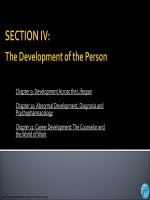The world of the Counselor An introduction to the counseling profession 5e chapter 1
Bạn đang xem bản rút gọn của tài liệu. Xem và tải ngay bản đầy đủ của tài liệu tại đây (458.83 KB, 26 trang )
Chapter 1: The Counselor's Identity: What, Who, and How?
Chapter 2: The Counseling Profession’s Past, Present, and
Future
Chapter 3: Standards in the Profession: Ethics, Accreditation,
Credentialing and Multicultural/Social Justice Competencies
© 2007 Thomson Brooks/Cole, a division of Thomson Learning
1
The Counselor's Identity:
What, Who, and How?
© 2007 Thomson Brooks/Cole, a division of Thomson Learning
2
Guidance, Counseling and Psychotherapy: Variations on
Same Theme?
Definitions
Guidance
Counseling
Psychotherapy
▪ See Figure 1.1, p. 4
© 2007 Thomson Brooks/Cole, a division of Thomson Learning
3
The following PowerPoint slides lists a number of
professionals in the field. For each, see if you can
identify the following:
Major professional organization(s)
Major roles and functions
Names and types of credentials
Names of accrediting body associated with it
© 2007 Thomson Brooks/Cole, a division of Thomson Learning
4
Counselors
School Counselors
Clinical Mental Health Counselors (Agency Counselors)
Marriage, Couple, and Family Counselors
Student Affairs and College Counselors
Addiction Counselors
Rehabilitation Counselors
Pastoral Counselors
© 2007 Thomson Brooks/Cole, a division of Thomson Learning
5
Social Workers
Psychoanalysts
Psychologists
Clinical Psychologists
Counseling
Psychologists
School Psychologists
Psychiatric-Mental Health
Nurses
Expressive Therapists
Human Service Practitioners
Psychotherapists
Psychiatrists
© 2007 Thomson Brooks/Cole, a division of Thomson Learning
6
Benefits of:
National and regional conferences
Access to malpractice insurance
Lobbyists
Newsletters and journals
Mentoring and networking
Information on cutting-edge issues in the field
Codes of ethics and standards for practice
Job banks
© 2007 Thomson Brooks/Cole, a division of Thomson Learning
7
ACA American Counseling Association
19 Divisions of ACA (see pp. 12-13)
Associations Related to ACA
▪ ACAIT: ACA Insurance Trust
▪ ACAF: American Counseling Association Foundation
CACREP: Council for the Accreditation of Counseling and
Related Educational Programs
▪ CORE: Council on Rehabilitation Education
▪ NBCC: National Board for Certified Counselors
▪ CSI: Chi Sigma Iota
© 2007 Thomson Brooks/Cole, a division of Thomson Learning
8
ACA American Counseling Association (Cont’d)
Branches of ACA
▪ 56 Branches
▪ 50 state branches
▪ Puerto Rico and Washington D. C.
▪ Associations in Latin America
Four Regional Associations in U. S.
Membership Benefits of ACA (see Bottom of p. 14)
© 2007 Thomson Brooks/Cole, a division of Thomson Learning
9
AATA: American Art Therapy Association
AAMFT: American Association of Marriage & Family Therapists
APA: American Psychiatric Association
APNA: American Psychiatric Nurses Association
APA: American Psychological Association
NASW: National Association of Social Workers
NOHS: National Organization for Human Services
© 2007 Thomson Brooks/Cole, a division of Thomson Learning
10
9 Common Factors
6 “Working Alliance”
3 “other:
© 2007 Thomson Brooks/Cole, a division of Thomson Learning
11
Empathy
More than any other component, most related to positive
client outcomes
See Rogers’ definition, p. 18
A personal characteristic to embrace
A skill to learn (Chapter 5 will address this)
© 2007 Thomson Brooks/Cole, a division of Thomson Learning
12
Acceptance
Sometimes called “Positive Regard”
Foundation for a therapeutic alliance
An attitude that regardless of what the client says, he or
she will be respected
Suspension of judgment
In some manner, almost all counseling approaches stress
acceptance of client and client acceptance of self
© 2007 Thomson Brooks/Cole, a division of Thomson Learning
13
•
Genuineness
• Refers to willingness of the therapist to be authentic,
open, and honest within the helping relationship
• Gelso and Carter: All counseling relationships have to deal
with the “real relationship” between the counselor and
client
• Research on genuineness shows that it may be important
in client outcomes
• May be related to emotional intelligence (ability to
monitor one’s emotions)
© 2007 Thomson Brooks/Cole, a division of Thomson Learning
14
Embracing a wellness perspective
Counselors can easily become stressed, burnt out, have
compassion fatigue, and experience vicarious traumatization
All of above can lead to countertransference
Myers and Sweeney suggest attending to:
▪ Creative Self; Coping Self; Social Self; Essential Self;
Physical Self
▪ See table 1.1 page 21
Personal Therapy? (85% of helpers have done it!)
Other ways?
© 2007 Thomson Brooks/Cole, a division of Thomson Learning
15
Cultural Competence
Clients from nondominant groups are sometimes
distrustful of counselors.
They are often misunderstood, misdiagnosed, find
counseling unhelpful, attend counseling less frequently,
and drop out more quickly.
Since culture influences ALL relationships, throughout this
text, and especially in chapters 14 and 15, cultural
competence will be discussed
© 2007 Thomson Brooks/Cole, a division of Thomson Learning
16
Cultural Competence (Cont’d)
For now, consider D’Andrea and Daniel’s RESPECTFUL model:
R – Religious/spiritual identity
E – Economic class background
S – Sexual identity
P – Psychological development
E – Ethnic/racial identity
C – Chronological disposition
T – Trauma and other threats to their personal well-being
F – Family history
U – Unique physical characteristics
L – Language and location of residence
© 2007 Thomson Brooks/Cole, a division of Thomson Learning
17
The “It” Factor
The unique way that each therapist has of working with
clients.
Using your unique personality to connect with the client
and build a working relatinoship.
What is your “it” factor?
© 2007 Thomson Brooks/Cole, a division of Thomson Learning
18
Compatibility with and Belief in a Theory
As counselors, we have to find a theory that “fits” our
personality style
Helpers are usually attracted to theories that they find
comfortable.
The more you feel comfortable, like, and understand your
theory, the more you will believe in it.
Strong belief in a theory helps clients believe in the
helper’s approach and yields better client outcomes
© 2007 Thomson Brooks/Cole, a division of Thomson Learning
19
Competence
Counselor expertise (mastery) has been shown to be a
crucial element for client success in counseling
Perceived incompetence is often sensed by clients
Demonstrated through helper’s desire to:
▪ Join professional associations
▪ Mentoring and supervising
▪ Reading professional journals
▪ Continuing education
▪ More!
© 2007 Thomson Brooks/Cole, a division of Thomson Learning
20
Competence (Cont’d)
Shown throughout ACA’s ethical code:
1. practicing within one’s boundary of competence
2. practicing only in one’s specialty areas
3. accepting employment only for qualified positions
4. monitoring one’s effectiveness
5. knowing when to consult with others
6. keep current by attending continuing education activities
7. don’t offer services if physically or emotionally impaired
8. assure proper transfer of cases when incapacitated or leaves a
practice (ACA, 2005, Standard C.2)
© 2007 Thomson Brooks/Cole, a division of Thomson Learning
21
Cognitive Complexity
Cognitive complexity means you are a:
▪ Helper who believes in your theory but able to question it
▪ Critical thinker
▪ Helper who views the world from multiple perspectives
▪ Likely more empathic, open, and self-aware
▪ Better able to cure “ruptures” in the counseling relationship
▪ Person who is not seeking “truth”
▪ A person who does seek the best way to help your client
Hopefully, your program will support you and challenge you to
view situations in new and complex ways.
© 2007 Thomson Brooks/Cole, a division of Thomson Learning
22
Inclusion of Multiculturalism in the Profession
Small number of person from culturally diverse groups
entering counseling profession
We all need to make the helping professions attractive for
people of color
To become culturally competent, all counselors must:
1.Learn counseling strategies that work for all clients
2.Work with client s from diverse backgrounds
3.Gain a deep appreciation for diversity
4.Acquire an identity as a counselor that includes a
multicultural perspective
© 2007 Thomson Brooks/Cole, a division of Thomson Learning
23
Knowing Who We Are and Our Relationship To Other Professionals
Professional identity gives us a sense of who we are, and who we are not.
▪ Helps us know:
▪ how to practice only within our areas of competence
▪ when to consult with other, related mental health
professionals
▪ when to refer clients because of our lack of expertise
▪ when to refer clients due to lack of cross-cultural knowledge
and skills with some clients
© 2007 Thomson Brooks/Cole, a division of Thomson Learning
24
Impaired Mental Health Professionals
We have a responsibility to know when an impairment will
negatively affect our clients
Know to seek help for our problems
Know when to “limit, suspend, or terminate” work if our
impairment negatively affects others
Impairment can lead to incompetence
▪ Incompetence is unethical and can be illegal and lead to
malpractice suits
© 2007 Thomson Brooks/Cole, a division of Thomson Learning
25









